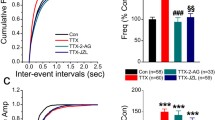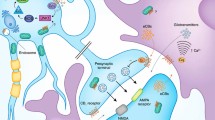Abstract
Endocannabinoids (eCBs) modulate both excitatory and inhibitory neurotransmission in hippocampus via activation of pre-synaptic cannabinoid receptors. Here, we present a model for cannabinoid mediated short-term depression of excitation (DSE) based on our recently developed model for the equivalent phenomenon of suppressing inhibition (DSI). Furthermore, we derive a simplified formulation of the calcium-mediated endocannabinoid synthesis that underlies short-term modulation of neurotransmission in hippocampus. The simplified model describes cannabinoid-mediated short-term modulation of both hippocampal inhibition and excitation and is ideally suited for large network studies. Moreover, the implementation of the simplified DSI/DSE model provides predictions on how both phenomena are modulated by the magnitude of the pre-synaptic cell’s activity. In addition we demonstrate the role of DSE in shaping the post-synaptic cell’s firing behaviour qualitatively and quantitatively in dependence on eCB availability and the pre-synaptic cell’s activity. Finally, we explore under which conditions the combination of DSI and DSE can temporarily shift the fine balance between excitation and inhibition. This highlights a mechanism by which eCBs might act in a neuro-protective manner during high neural activity.






Similar content being viewed by others
References
Alger, B.E. (2002). Retrograde signaling in the regulation of synaptic transmission: focus on endocannabinoids. Progress in Neurobiology, 68(4), 247–286.
Blair, R.E. (2006). Activation of the cannabinoid type-1 receptor mediates the anticonvulsant properties of cannabinoids in the hippocampal neuronal culture models of acquired epilepsy and status epilepticus. Journal of Pharmacology and Experimental Therapeutics, 317(3), 1072–1078.
Chen, K., Neu, A., Howard, A.L., Foldy, C., Echegoyen, J., Hilgenberg, L., Smith, M., Mackie, K., Soltesz, I. (2007). Prevention of plasticity of endocannabinoid signaling inhibits persistent limbic hyperexcitability caused by developmental seizures. Journal of Neuroscience, 27(1), 46–58.
Diana, M.A., & Marty, A. (2004). Endocannabinoid-mediated short-term synaptic plasticity: depolarization-induced suppression of inhibition (DSI) and depolarization-induced suppression of excitation (DSE). British Journal of Pharmacology, 142(1), 9–19.
Földy, C., Neu, A., Jones, M.V., Soltesz, I. (2006). Presynaptic, activity-dependent modulation of cannabinoid type 1 receptor-mediated inhibition of GABA release. Journal of Neuroscience, 26(5), 1465–1469.
Gao, Y., Vasilyev, D.V., Goncalves, M.B., Howell, F.V., Hobbs, C., Reisenberg, M., Shen, R., Zhang, M.Y., Strassle, B.W., Lu, P., et al (2010). Loss of retrograde endocannabinoid signaling and reduced adult neurogenesis in diacylglycerol lipase knock-out mice. Journal of Neuroscience, 30(6), 2017–2024.
Glickfeld, L.L., & Scanziani, M. (2006). Distinct timing in the activity of cannabinoid-sensitive and cannabinoid-insensitive basket cells. Nature Neuroscience, 9(6), 807–815.
Goodman, D.F.M. (2009). The brian simulator. Frontiers in Neuroscience, 3(2), 192–197.
Guo, J., & Ikeda, S.R. (2004). Endocannabinoids modulate N-type calcium channels and G-protein-coupled inwardly rectifying potassium channels via CB1 cannabinoid receptors heterologously expressed in mammalian neurons. Molecular Pharmacology, 65(3), 665–674.
Hajos, N., & Freund, T.F. (2002). Distinct cannabinoid sensitive receptors regulate hippocampal excitation and inhibition. Chemistry and Physics of Lipids, 121(1–2), 73–82.
Hashimotodani, Y., Ohno-Shosaku, T., Watanabe, M., Kano, M. (2007). Roles of phospholipase cbeta and NMDA receptor in activity-dependent endocannabinoid release. Journal of Physiology, 584, 373–380.
Hemond, P., Epstein, D., Boley, A., Migliore, M., Ascoli, G.A., Jaffe, D.B. (2008). Distinct classes of pyramidal cells exhibit mutually exclusive firing patterns in hippocampal area CA3b. Hippocampus, 18(4), 411–424.
Hines, M.L., Morse, T., Migliore, M., Carnevale, N.T., Shepherd, G.M. (2004). Modeldb: A database to support computational neuroscience. Journal of Computational Neuroscience, 17(1), 7–11.
Huguenard, J., & Mccormick, D.A. (1994). Electrophysiology of the neuron: an interactive tutorial. New York: Oxford University Press.
Iremonger, K.J., Wamsteeker Cusulin, J.I., Bains, J.S. (2013). Changing the tune: plasticity and adaptation of retrograde signals. Trends in Neurosciences, 36(8), 471–479.
Kano, M., Ohno-Shosaku, T., Hashimotodani, Y., Uchigashima, M., Watanabe, M. (2009). Endocannabinoid-mediated control of synaptic transmission. Physiological Reviews, 89(1), 309–380.
Kim, J., & Alger, B.E. (2004). Inhibition of cyclooxygenase-2 potentiates retrograde endocannabinoid effects in hippocampus. Nature Neuroscience, 7(7), 697–698.
Lenz, R.A., & Alger, B.E. (1999). Calcium dependence of depolarization-induced suppression of inhibition in rat hippocampal CA1 pyramidal neurons. Journal of Physiology, 521, 147–157.
Marsicano, G. (2003). Cb1 cannabinoid receptors and on-demand defense against excitotoxicity. Science, 302(5642), 84–88.
MATLAB (2010). version 7.10.0 (R2010a). The MathWorks Inc., Natick, Massachusetts.
Monory, K., & Lutz, B. (2008). The endocannabinoid system as a therapeutic target in epilepsy. Cannabinoids and the Brain, 407–422.
Monory, K., Massa, F., Egertová, M., Eder, M., Blaudzun, H., Westenbroek, R., Kelsch, W., Jacob, W., Marsch, R., Ekker, M., et al (2006). The endocannabinoid system controls key epileptogenic circuits in the hippocampus. Neuron, 51(4), 455–466.
Morishita, W., & Alger, B.E. (1999). Evidence for endogenous excitatory amino acids as mediators in DSI of GABA(A)ergic transmission in hippocampal CA1. Journal of Neurophysiology, 82, 2556–2564.
Nowacki, J. (2011). Xppy. URL http://seis.bris.ac.uk/enxjn/xppy/.
Ohno-Shosaku, T., Maejima, T., Kano, M. (2001). Endogenous cannabinoids mediate retrograde signals from depolarized postsynaptic neurons to presynaptic terminals. Neuron, 29(3), 729–738.
Ohno-Shosaku, T., Shosaku, J., Tsubokawa, H., Kano, M. (2002a). Cooperative endocannabinoid production by neuronal depolarization and group i metabotropic glutamate receptor activation. European Journal of Neuroscience, 15(6), 953–961.
Ohno-Shosaku, T., Tsubokawa, H., Mizushima, I., Yoneda, N., Zimmer, A., Kano, M. (2002b). Presynaptic cannabinoid sensitivity is a major determinant of depolarization-induced retrograde suppression at hippocampal synapses. Journal of Neuroscience, 22(10), 3864–3872.
Pan, B., Wang, W., Zhong, P., Blankman, J.L., Cravatt, B.F., Liu, Q. (2011). Alterations of endocannabinoid signaling, synaptic plasticity, learning, and memory in monoacylglycerol lipase knock-out mice. Journal of Neuroscience, 31(38), 13, 420–13, 430.
Peterfi, Z., Urban, G.M., Papp, O.I., Nemeth, B., Monyer, H., Szabo, G., Erdelyi, F., Mackie, K., Freund, T.F., Hajos, N., et al (2012). Endocannabinoid-mediated long-term depression of afferent excitatory synapses in hippocampal pyramidal cells and gabaergic interneurons. Journal of Neuroscience, 32(41), 14, 448–14, 463.
Piomelli, D., Giuffrida, A., Calignano, A., Rodriguez de Fonseca, F. (2000). The endocannabinoid system as a target for therapeutic drugs. Trends in Pharmacological Sciences, 21(6), 218–224.
De Schutter, E., & Smolen, P. (1998). Methods in neuronal modeling: from ions to networks, The MIT Press, chapter Calcium dynamics in large neuronal models.
Shinomoto, S., & Sakai, Y. (1999). Inter-spike interval statistics of cortical neurons. Lecture Notes in Computer Science, 171–179.
Straiker, A., Wager-Miller, J., Hu, S.S., Blankman, J.L., Cravatt, B.F., Mackie, K. (2011). COX-2 and fatty acid amide hydrolase can regulate the time course of depolarization-induced suppression of excitation. British Journal of Pharmacology, 164(6), 1672–1683.
Tanimura, A., Yamazaki, M., Hashimotodani, Y., Uchigashima, M., Kawata, S., Abe, M., Kita, Y., Hashimoto, K., Shimizu, T., Watanabe, M., Sakimura, K., Kano, M. (2010). The endocannabinoid 2-arachidonoylglycerol produced by diacylglycerol lipase alpha mediates retrograde suppression of synaptic transmission. Neuron, 65, 320–327.
Traub, R.D., & Miles, R. (1991). Neuronal Networks of the Hippocampus. New York: Cambridge University Press.
Wang, J., & Zucker, R.S. (2001). Photolysis-induced suppression of inhibition in rat hippocampal CA1 pyramidal neurons. Journal of Physiology, 533 (Pt 3), 757–763.
Wang, X.J., & Buzsaki, G. (1996). Gamma oscillation by synaptic inhibition in a hippocampal interneuronal network. Journal of Neuroscience, 16, 6402–6413.
Wilson, R.I., & Nicoll, R.A. (2001). Endogenous cannabinoids mediate retrograde signalling at hippocampal synapses. Nature, 410(6828), 1–4.
Zachariou, M., Alexander, S.P., Coombes, S., Christodoulou, C. (2013). A biophysical model of endocannabinoid-mediated short term depression in hippocampal inhibition. PloS ONE, 8(3), e58,926.
Acknowledgements
The authors would like to thank Chris Christodoulou and Stephen Coombes for useful comments and discussions. The authors also wish to acknowledge the anonymous reviewers for their helpful comments to the manuscript. This work was co-funded by the European Regional Development Fund and the Republic of Cyprus through the Research Promotion Foundation (DIDAKTOR/0609/12) and by a Young Researchers grant from the University of Cyprus.
Author information
Authors and Affiliations
Corresponding author
Additional information
Action Editor: Claudia Clopath
Conflict of interest
The authors declare that they have no conflict of interest.
Rights and permissions
About this article
Cite this article
Zachariou, M., Thul, R. Cannabinoid-mediated short-term plasticity in hippocampus. J Comput Neurosci 37, 533–547 (2014). https://doi.org/10.1007/s10827-014-0518-4
Received:
Revised:
Accepted:
Published:
Issue Date:
DOI: https://doi.org/10.1007/s10827-014-0518-4




